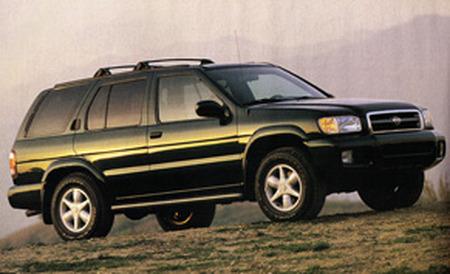Thumbing through the Car and Driver archives, we have to look way back to April 1996 for the most recent comprehensive review of a Nissan Pathfinder. That was a comparison test between seven sport utes –the just-restyled Pathfinder, the Acura SLX, Ford Explorer XLT, Jeep Grand Cherokee Limited, Land Rover Discovery, Oldsmobile Bravada, and Toyota 4Runner SR5.
The Toyota won, with the Pathfinder a reasonably close second, bolstered by its “creamy off-road ride,” its “high-quality feel,” and its surprising sure-footedness when creeping along a rocky trail.
Its shortcoming was the engine –a weak-willed 3.3-liter V-6 that gave the Pathfinder a 0-to-60 mph time of 11 seconds, a tenth of a second faster than the portly Land Rover, but slower than the other five SUVs. Quite a bit slower, in several cases –the V-8 in the Jeep gave it a best-in-class 9.1-second 0-to-60 time, with the Ford and Toyota tied for second at 9.5 seconds. That’s especially impressive for the Toyota, which, unlike the Ford and Jeep, but like the Nissan, was powered by a V-6. That the Pathfinder could do as well as it did with such an absence of cojones speaks to how fond we were of the rest of the package.
Even though it received a face lift midway through the 1999 model year, the reason we haven’t revisited the Pathfinder since then is because we haven’t had a compelling reason to. Until now.
Nissan has anted up a DOHC, 24-valve 3.5-liter V-6 for the Pathfinder (and its luxo-twin, the Infiniti QX4, as noted in the accompanying story), and suddenly we’re getting a V-8-caliber 0-to-60 mph time of 9.2 seconds, with quarter-mile performance of 17.0 seconds at 80 mph, instead of 18.2 seconds at an are-we-there-yet 74 mph.
Although this performance doesn’t move the Pathfinder to the top of the SUV performance heap, the improvement is welcome, even though we don’t plan to drag-race our SUVs. One trip through the mountains, however, in a 170-hp, 3.3-liter, 12-valve, SOHC Pathfinder, listening to the transmission shift up and down incessantly as it tries to locate a little power, is just no fun. That’s no longer an issue.
This new engine uses the architecture and much of the technology introduced in the Nissan Maxima powerplant, but Nissan claims that more than 100 refinements and improvements were made for the Pathfinder application. Fuel mileage equals the 3.3-liter’s numbers, but –thanks to the aluminum block –the engine weighs 35 fewer pounds than the iron-block 3.3.
The 3.5-liter is part of Nissan’s VQ engine series, like the VQ30DE introduced in 1995 in the Maxima. The Pathfinder’s engine is the VQ35DE, and Nissan insists it’s more than a bored-out Maxima powerplant, as the emphasis is on low-end power. That said, the variable intake system (an internal valve shortens the effective length of the intake runners as rpm increases) arrives pretty much intact from the Maxima, but that system is better exploited by teaming it with Nissan’s new continuous valve-timing control system. Our tester had the revised four-speed electronically controlled automatic, but a five-speed manual is available on the SE model. (The base trim level is the $28,169 XE, in the middle is the “sporty and rugged” SE, with the “luxurious” LE on top at $29,819, and each is available with four-wheel-drive for $2000.) Pick the manual SE and you get 250 horsepower (10 more than with the automatic), but the retuning gets you 240 pound-feet of torque instead of the automatic’s 265 pound-feet. We’re told that’s a durability concern regarding the manual tranny.
Towing capacity is 3500 pounds for the manual, 5000 for the automatic. The old 3.3-liter could tow 5000 pounds, so why isn’t the new model, given its extra oomph, able to tow more? Overheating concerns, we were told.
Otherwise, there isn’t a whole lot new for this new 2001 model. The instrument panel and center console have been redesigned, but the exterior looks very much like the 1999.5 model, which didn’t stray far from the redesign introduced in 1996, the first year for this current-generation model. Quite a bit of equipment has been made standard, including a six-speaker AM/FM stereo with cassette and CD player, and 16-inch aluminum wheels –a different design for each of the three models. Side airbags are available on the SE and LE models if you opt for the leather package.
Fortunately, Nissan left alone what we liked best about the unibody (or MonoFrame, as Nissan calls it) Pathfinder –the independent-strut front suspension and the five-link, rigid-axle rear suspension, with coil springs at all four corners. It remains exceptionally smooth-riding without a trace of mushiness on the road, and off-road it’s agile and sure-footed. The P255/65SR-16 Bridgestone Dueler tires on our test vehicle were quiet and well-suited for pavement, and are a decent compromise for occasional off-roading, but serious dirt-drivers will want more capable rubber. Four-wheel-drive models have a shift-on-the-fly transfer case, so long as you’re flying at no more than 50 mph.
With the 2001 Pathfinder and 2001 Sentra added to the current, and competent, Maxima, Frontier, Xterra, and Altima, the company suddenly has a potent lineup. Well done, Nissan.


Leave a Reply